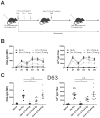Tracing Donor-MHC Class II Reactive B cells in Mouse Cardiac Transplantation: Delayed CTLA4-Ig Treatment Prevents Memory Alloreactive B-Cell Generation
- PMID: 27362308
- PMCID: PMC4961602
- DOI: 10.1097/TP.0000000000001253
Tracing Donor-MHC Class II Reactive B cells in Mouse Cardiac Transplantation: Delayed CTLA4-Ig Treatment Prevents Memory Alloreactive B-Cell Generation
Abstract
Background: The dual role of B cells as drivers and suppressors of the immune responses have underscored the need to trace the fate of B cells recognizing donor major histocompatibility complex class I and class II after allograft transplantation.
Methods: In this study, we used donor class II tetramers to trace the fate of I-E-specific B cells after immunization with BALB/c spleen cells or cardiac transplantation, in naive or sensitized C57BL/6 recipients. We combined this approach with genetic lineage tracing of memory B cells in activation-induced cytidine deaminase regulated Cre transgenic mice crossed to the ROSA26-enhanced yellow fluorescent protein reporter mice to track endogenous I-E-specific memory B cell generation.
Results: Immunization with BALB/c splenocytes or heart transplantation induced an expansion and differentiation of I-E-specific B cells into germinal center B cells, whereas BALB/c heart transplantation into sensitized recipients induced the preferential differentiation into antibody-secreting cells. A 10.8-fold increase in the frequency of I-E-specific memory B cells was observed by day 42 postimmunization. Treatment with CTLA4-Ig starting on day 0 or day 7 postimmunization abrogated I-E-specific memory B cell generation and sensitized humoral responses, but not if treatment commenced on day 14.
Conclusions: The majority of donor-specific memory B cells are generated between days 7 and 14 postimmunization, thus revealing a flexible timeframe whereby delayed CTLA4-Ig administration can inhibit sensitization and the generation of memory graft-reactive B cells.
Conflict of interest statement
The authors declare no conflicts of interest.
Figures





Comment in
-
Preventing Memory B Cell Formation: A Story of Mice and Men?Transplantation. 2016 Aug;100(8):1605-6. doi: 10.1097/TP.0000000000001254. Transplantation. 2016. PMID: 27362318 No abstract available.
References
-
- Gosset C, Lefaucheur C, Glotz D. New insights in antibody-mediated rejection. Curr Opin Nephrol Hypertens. 2014;23(6):597–604. - PubMed
-
- Halloran PF, Reeve JP, Pereira AB, Hidalgo LG, Famulski KS. Antibody-mediated rejection, T cell-mediated rejection, and the injury-repair response: new insights from the Genome Canada studies of kidney transplant biopsies. Kidney Int. 2014;85(2):258–264. - PubMed
-
- Wiebe C, Gibson IW, Blydt-Hansen TD, et al. Rates and Determinants of Progression to Graft Failure in Kidney Allograft Recipients With De Novo Donor-Specific Antibody. Am J Transplant. 2015;15(11):2921–2930. - PubMed
-
- Arias M, Rush DN, Wiebe C, et al. Antibody-mediated rejection: analyzing the risk, proposing solutions. Transplantation. 2014;98(Suppl 3):S3–21. - PubMed
Publication types
MeSH terms
Substances
Grants and funding
LinkOut - more resources
Full Text Sources
Other Literature Sources
Medical
Molecular Biology Databases
Research Materials

